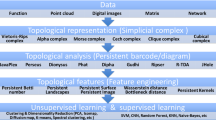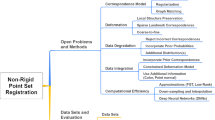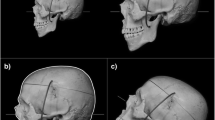Abstract
We present a skeleton computation algorithm for binary image shape which is stable and efficient. The algorithm follows these steps: first the shape boundary curves are subsampled, then the Voronoi Skeleton is computed from the resulting reduced boundary set of points, and finally, a novel two stage pruning procedure is applied to obtain a simplified skeleton. The first stage removes skeleton edges non fully included in the shape. The second stage applies an enhanced variation of the Discrete Curve Evolution (DCE) for Voronoi skeletons. We obtain improved skeleton stability, complexity reduction and noise robustness. Pruning computing time efficiency is improved thanks to some properties of Voronoi skeletons. Entire skeleton edges can be removed or retained on the basis of conditions tested on the edge endpoints. Pattern recognition experiments and skeleton stability experiments of the algorithm outperform previous approaches in the literature.
Similar content being viewed by others
References
Gonzalez, R., Woods, R.: Digital Image Processing, p. 543. Addison-Wesley/Longman, Reading/Harlow (2001), Chap. 9.5.7
Serra, J.: Image Analysis and Mathematical Morphology. Academic Press, San Diego (1982)
Rock, I., Linnett, C.M.: Is a perceived shape based on its retinal image? Perception 22(1), 61–76 (1993)
Hoffman, D., Richards, W.A.: Parts of recognition. Cognition 18, 65–96 (1984)
Blum, H.: Biological shape and visual science. Theor. Biol. 38, 205–287 (1973)
He, L., Han, C., Wee, W.: Object recognition and recovery by skeleton graph matching. In: IEEE International Conference on Multimedia and Expo, July 2006, pp. 993–996 (2006)
Eede, M.v., Macrini, D., Telea, A., Sminchisescu, C., Dickinson, S.S.: Canonical skeletons for shape matching. In: ICPR’06: Proceedings of the 18th International Conference on Pattern Recognition, pp. 64–69. IEEE Computer Society, Los Alamitos (2006)
Goh, W.-B.: Strategies for shape matching using skeletons. Comput. Vis. Image Underst. 110(3), 326–345 (2008)
Bai, X., Latecki, L.J., Liu, W.Y.: Skeleton pruning by contour partitioning with discrete curve evolution. IEEE Trans. Pattern Anal. Mach. Intell. 29(3), 449–462 (2007)
Beristain, A., Graña, M.: A pruning algorithm for Voronoi skeletons. Electron. Lett. 46(1), 39–41 (2010)
Biasotti, S., Attali, D., Boissonnat, J., Edelsbrunner, H., Elber, G., Mortara, M., Sanniti di Baja, G., Spagnuolo, M., Tanase, M., Veltcamp, R.: Skeletal structures. In: Shape Analysis and Structuring, pp. 172–175. Springer, Berlin (2008)
Reeb, G.: Sur les points singuliers d’une forme de pfaff completement integrable ou dune fonction numerique. C. R. Acad. Sci. 222, 847–849 (1946)
Shinagawa, Y., Kunii, T.L., Kergosien, Y.L.: Surface coding based on Morse theory. IEEE Comput. Graph. Appl. 11(5), 66–78 (1991)
Blum, H.: A transformation for extracting new descriptors of shape. In: Dunn, W.W. (ed.) Models for the Perception of Speech and Visual Form, pp. 362–380. MIT Press, Cambridge (1967)
Bruce, J., Giblin, P.J., Gibson, C.G.: Symmetry sets. Proc. R. Soc. Edinb. 104(A), 179–204 (1985)
Jain, A.K.: Fundamentals of Digital Image Processing, p. 387. Prentice-Hall, New York (1989), Chap. 9.9
Mather, J.: Distance from a submanifold in euclidean space. Proc. Symp. Pure Math., Ser. 2 40(2), 199–216 (1983)
Giblin, P.J., Kimia, B.B.: On the local form and transitions of symmetry sets, medial axes, and shocks. Int. J. Comput. Vis. 54(1–3), 143–156 (2003)
Giblin, P., Kimia, B.B.: A formal classification of 3d medial axis points and their local geometry. IEEE Trans. Pattern Anal. Mach. Intell. 26(2), 238–251 (2004)
Kimia, B.B., Tannenbaum, A.R., Zucker, S.W.: Shapes, shocks, and deformations i: the components of two-dimensional shape and the reaction-diffusion space. Int. J. Comput. Vis. 15(3), 189–224 (1995)
Bai, X., Latecki, L.: Discrete skeleton evolution. In: Energy Minimization Methods in Computer Vision and Pattern Recognition. Lecture Notes in Computer Science, vol. 4679, pp. 362–374. Springer, Berlin (2007)
Hesselink, W., Roerdink, J.: Euclidean skeletons of digital image and volume data in linear time by the integer medial axis transform. IEEE Trans. Pattern Anal. Mach. Intell. 30(12), 2204–2217 (2008)
Lam, L., Lee, S., Suen, C.: Thinning methodologies: A comprehensive survey. IEEE Trans. Pattern Anal. Mach. Intell. 14(9), 869–885 (1992)
Siddiqi, K., Pizer, S.: Medial Representations: Mathematics, Algorithms and Applications. Springer, Berlin (2008)
Torsello, A.: Matching hierarchical structures for shape recognition. Ph.D. dissertation, University of York, July 2004
Giardina, C., Dougherty, E.: Morphological Methods in Image and Signal Processing. Prentice Hall, New York (1988)
Jang, B., Chin, R.: Analysis of thinning algorithms using mathematical morphology. IEEE Trans. Pattern Anal. Mach. Intell. 12(6), 541–551 (1990)
Leymarie, F., Levine, M.: Simulating the grassfire transform using an active contour model. IEEE Trans. Pattern Anal. Mach. Intell. 14(1), 56–75 (1992)
Tek, H., Kimia, B.: Symmetry maps of free-form curve segments via wave propagation. In: The Proceedings of the Seventh IEEE International Conference on Computer Vision, 1999, vol. 1, pp. 362–369 (1999)
Tari, Z.S.G., Shah, J., Pien, H.: Extraction of shape skeletons from grayscale images. Comput. Vis. Image Underst. 66(2), 133–146 (1997)
Rosenfeld, A., Pfaltz, J.L.: Sequential operations in digital picture processing. J. ACM 13(4), 471–494 (1966)
Rosenfeld, A., Pfaltz, J.: Distance functions on digital pictures. Pattern Recognit. 1(1), 33–61 (1968)
Ogniewicz, R., Ilg, M.: Voronoi skeletons: theory and applications. In: IEEE Computer Society Conference on Computer Vision and Pattern Recognition, Proceedings CVPR’92, pp. 63–69 (1992)
Brandt, J.W., Algazi, V.R.: Continuous skeleton computation by Voronoi diagram. CVGIP, Image Underst. 55(3), 329–338 (1992)
Choi, S.W., Seidel, H.-P.: Linear onesided stability of mat for weakly injective 3d domain. In: SMA’02: Proceedings of the Seventh ACM Symposium on Solid Modeling and Applications, pp. 344–355. ACM, New York (2002)
Attali, D., Lachaud, J.O.: Delaunay conforming iso-surface, skeleton extraction and noise removal. Comput. Geom., Theory Appl. 19, 175–189 (2001)
Dey, T.K., Zhao, W.: Approximate medial axis as a Voronoi subcomplex. In: SMA’02: Proceedings of the Seventh ACM Symposium on Solid Modeling and Applications, pp. 356–366. ACM, New York (2002)
Foskey, M., Lin, M.C., Manocha, D.: Efficient computation of a simplified medial axis. In: SM’03: Proceedings of the Eighth ACM Symposium on Solid Modeling and Applications, pp. 96–107. ACM, New York (2003)
Mokhtarian, F., Mackworth, A.K.: A theory of multiscale, curvature-based shape representation for planar curves. IEEE Trans. Pattern Anal. Mach. Intell. 14(8), 789–805 (1992)
Shaked, D., Bruckstein, A.: Pruning medial axes. Comput. Vis. Image Underst. 69(2), 156–169 (1998)
Wets, R.J.-B., Tyrrell Rockafellar, R., Wets, M.: Set convergence. In: Variational Analysis, p. 117. Springer, Berlin (2009)
Brandt, J.W.: Convergence and continuity criteria for discrete approximations of the continuous planar skeleton. CVGIP, Image Underst. 59(1), 116–124 (1994)
Schmitt, M.: Some examples of algorithms analysis in computational geometry by means of mathematical morphology techniques. In: Geometry and Robotics, vol. 391, pp. 225–246. Springer, Berlin (1989)
Aronov, B.: A lower bound on Voronoi diagram complexity. Inf. Process. Lett. 83(4), 183–185 (2002)
Attali, D.: r-regular shape reconstruction from unorganized points. In: SCG’97: Proceedings of the Thirteenth Annual Symposium on Computational Geometry, pp. 248–253. ACM, New York (1997)
Chazal, F., Lieutier, A.: The “$lambda$-medial axis”. Graph. Models 67(4), 304–331 (2005)
Latecki, L.J., Lakämper, R.: Convexity rule for shape decomposition based on discrete contour evolution. Comput. Vis. Image Underst. 73(3), 441–454 (1999)
Latecki, L.J., Lakämper, R.: Shape similarity measure based on correspondence of visual parts. IEEE Trans. Pattern Anal. Mach. Intell. 22(10), 1185–1190 (2000)
Latecki, L.J., Lakämper, R.: Application of planar shape comparison to object retrieval in image databases. Pattern Recognit. 35, 15–29 (2002)
Available: http://www.cis.temple.edu/~latecki/Programs/skeletonPruning07.htm
Jeannin, S., Bober, M.: Description of core experiments for MPEG-7 motion/shape, MPEG-7 Std. (1999)
Beristain, A.: Conjunto de datos de test mpeg-7 core experiment ce-shape-1 (2009). Available: http://www.ehu.es/ccwintco/index.php/GIC-experimental-databases
Beristain, A.: Colección de imágenes para entrenamiento de un reconocedor de gestos de interacción con un tabletop (2009). Available: http://www.ehu.es/ccwintco/index.php/Synthetic_hand_gesture_images_for_tabletop_interaction
Specht, D.F.: Probabilistic neural networks. Neural Netw. 3(1), 109–118 (1990)
Author information
Authors and Affiliations
Corresponding author
Rights and permissions
About this article
Cite this article
Beristain, A., Graña, M. & Gonzalez, A.I. A Pruning Algorithm for Stable Voronoi Skeletons. J Math Imaging Vis 42, 225–237 (2012). https://doi.org/10.1007/s10851-011-0291-1
Published:
Issue Date:
DOI: https://doi.org/10.1007/s10851-011-0291-1




